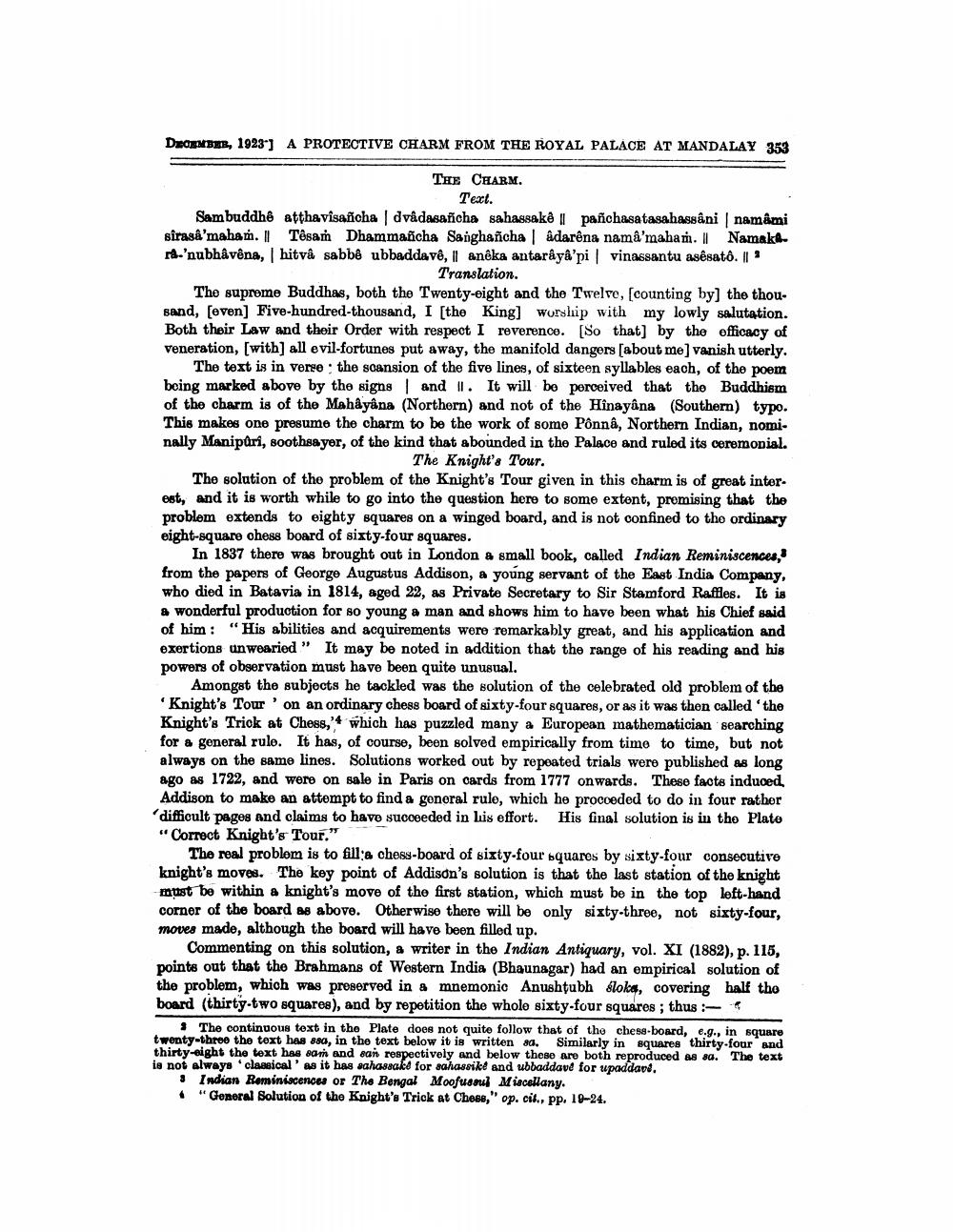________________
DWOMBRE, 1923-) A PROTECTIVE CHARM FROM THE ROYAL PALACE AT MANDALAY 353
--F1-441 LHATJUKE
THE CHARM.
Text. Sambuddhé atthavisancha | dvadasañcha sahassake || panchasatasahassani namami sirasâ'mahan. Tosam Dhammancha Sanghanchal adarêna nama'maham. | Namakt. ra-'nubhavêna, hitvå sabbê ubbadda vê, l aneka antarâyâ'pi vina.santu asêsato. |
Translation. The supreme Buddhas, both the Twenty-eight and the Twelve, [counting by] the thousand, [even] Five-hundred-thousand, I [the King] worship with my lowly salutation. Both their Law and their Order with respect I reverence. (So that] by the efficacy of veneration, [with] all evil-fortunes put away, the manifold dangers [about me) vanish utterly.
The text is in verse: the soansion of the five lines, of sixteen syllables each, of the poem being marked above by the signs and I. It will be perceived that the Buddhism of the charm is of the Mahåyåna (Northern) and not of the Hinayana (Southern) typo. This makes one presume the charm to be the work of some PÔnnå, Northern Indian, nominally Manipuri, soothsayer, of the kind that abounded in the Palace and ruled its ceremonial.
The Knight's Tour. The solution of the problem of the Knight's Tour given in this charm is of great interest, and it is worth while to go into the question here to some extent, promising that the problem extends to eighty squares on a winged board, and is not confined to the ordinary eight-square ohess board of sixty-four squares.
In 1837 there was brought out in London a small book, called Indian Reminiscences, from the papers of George Augustus Addison, a young servant of the East India Company, who died in Batavia in 1814, aged 22, as Private Secretary to Sir Stamford Raffles. It is a wonderful production for so young a man and shows him to have been what his Chief said of him: "His abilities and acquirements were remarkably great, and his application and exertions unwearied " It may be noted in addition that the range of his reading and his powers of observation must have been quite unusual.
Amongst the subjects he tackled was the solution of the celebrated old problem of the Knight's Tour on an ordinary chess board of sixty-four squares, or as it was then called 'the Knight's Trick at Chess,'' which has puzzled many a European mathematician searching for a general rule. It has, of course, been solved empirically from time to time, but not always on the same lines. Solutions worked out by repeated trials were published as long ago as 1722, and were on sale in Paris on cards from 1777 onwards. These facts induced Addison to make an attempt to find a general rule, which he proceded to do in four rather difficult pages and claims to have succeeded in his effort. His final solution is in the Plato "Correct Knight's Tour."
The real problom is to fill;a chess-board of sixty-four squares by sixty-four consecutive knight's moves. The key point of Addison's solution is that the last station of the knight must be within a knight's move of the first station, which must be in the top left-hand corner of the board as above. Otherwise there will be only sixty-three, not sixty-four, moves made, although the board will have been filled up.
Commenting on this solution, a writer in the Indian Antiquary, vol. XI (1882), p. 115, points out that the Brahmans of Western India (Bhaunagar) had an empirical solution of the problem, which was preserved in a mnemonic Anushţubh bloka, covering half the board (thirty-two squares), and by repetition the whole sixty-four squares ; thus -
• The continuous text in the Plate does not quite follow that of the chese board, e.g., in square twenty-throo the toxt has 889, in the text below it is written 8a. Similarly in squares thirty-four and thirty-eight the text has ea and san respectively and below these are both reproduced as sa. The text is not always classical' as it has sahassakd for sahassikt and ubbaddavd for upaddant, 3 Indian Reminiscences or The Bengal Moofussul Miscellany.
"General Solution of the Knight's Trick at Chess," op. cit., pp. 19-24.




